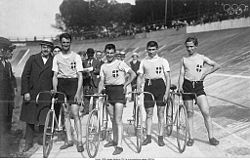 The golden Italian team of the team pursuit in the Garden City Velodrome during the 1920 Summer Olympics (Franco Giorgetti, Ruggero Ferrario, Arnaldo Carli and Primo Magna) The golden Italian team of the team pursuit in the Garden City Velodrome during the 1920 Summer Olympics (Franco Giorgetti, Ruggero Ferrario, Arnaldo Carli and Primo Magna) | |
 | |
| Location | Antwerp, Belgium |
|---|---|
| Coordinates | 51°10′N 04°23′E / 51.167°N 4.383°E / 51.167; 4.383 |
| Capacity | 15,000 |
| Field size | 400m length |
| Surface | Cement |
| Construction | |
| Opened | 28 June 1914 |
| Closed | 1925 |
| Years active | 1913–1925 |
| Architect | Hellner |
The Garden City Velodrome was a velodrome located in Antwerp, Belgium. A 400-metre track, it hosted the track cycling events for the 1920 Summer Olympics and the UCI Track Cycling World Championships that year.
History
Located in the Wilrijk district, the Garden City Velodrome was created to replace the demolished Zurenborg velodrome that was located in the Zurenborg area. The velodrome was ceremonially opened on June 28, 1914, the day of the assassination of Franz Ferdinand of Austria. This sparked a World War in which the cycling track was hardly used.
After the war, the facility was renovated. The first event held was the finish of the Tour of Belgium on 12 August 1919. On 9-10 August 1920, the track cycling competitions (sprints, tandems, a team race and a 50 km race) were held at the venue as part of the 1920 Summer Olympics. Due to high ticket prices, and the participation of only amateurs in the races, these competitions were not very popular.
A few days before the Olympic competition, the 23rd World Track Cycling Championships were also held on the track. Three competitions were held at the championships: an individual sprint for amateurs, an individual sprint for professionals and a motor-paced race for professionals.
Inside the track, the pitch was also used as a football field.
After 1920, the venue slowly declined in importance, mainly due to the poor condition of the concrete surface and the opening of new cycling tracks in the city. The last race at the track took place on 15 March 1925, and it was demolished shortly afterwards. Residential buildings were subsequently built in its place.
In Wilrijk, a street Garden Citylaan is named after this Olympic velodrome.
See also
References
- "Elsdonk - tuinwijk en wielerpiste". www.antwerpen.be (in Dutch). Retrieved 2021-08-07.
- "World Championships - Results Men 1919/1920". www.the-sports.org. Retrieved 2021-08-07.
- "In het spoor van de Olympische Spelen 1920". servicekoers.be (in Dutch). 23 July 2020.
- Bert Moeyaert. "Bijlage 18 : De wielerbanen van België van A tot Z". www.ethesis.net (in Dutch). Retrieved 2021-08-08.
This article about a Belgium sports venue is a stub. You can help Misplaced Pages by expanding it. |
This cycling venue-related article is a stub. You can help Misplaced Pages by expanding it. |
This article about a Summer Olympics venue is a stub. You can help Misplaced Pages by expanding it. |
- Buildings and structures completed in 1914
- Event venues established in 1914
- Sports venues completed in 1914
- Venues of the 1920 Summer Olympics
- Defunct sports venues in Belgium
- Velodromes in Belgium
- Olympic cycling venues
- Sports venues in Belgium
- Sports venues in Antwerp Province
- Buildings and structures in Antwerp
- Belgian sports venue stubs
- Cycling venue stubs
- Summer Olympic venue stubs
